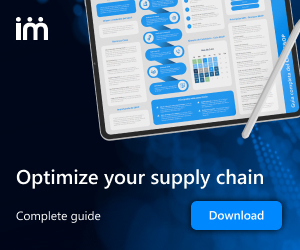Within the logistics sector, there is a fundamental concept that influences the efficiency and productivity of any supply chain: lead time. In today’s article, we will explore this concept in detail, from its definition to its impact on business competitiveness. We will delve into the different types of lead time in logistics, how it is measured and evaluated, as well as strategies and methods to optimize it.
What is lead time in the supply chain?
Lead time represents the amount of time that elapses from when an order is placed until it is completed and delivered to the final customer. It is a critical indicator in logistics and supply chain management as it directly influences customer satisfaction, operational costs, and the overall efficiency of the company.
There are different types of lead time, including production lead time, delivery lead time, procurement lead time, and replenishment lead time, each with its own characteristics and variables that impact the planning and execution of logistics operations. Lead time is an essential metric that allows organizations to anticipate and efficiently manage delivery times, thereby optimizing their processes and maximizing their competitiveness.
Types of lead time in the supply chain
In the supply chain, lead time is broken down into several types that cover different stages of the process. Each of these types of lead time plays a crucial role in the planning and management of the supply chain, allowing companies to optimize their operations and meet demand more efficiently. These include:
- Procurement lead time: the time that elapses from when a materials order is placed until it arrives at the warehouse.
- Production lead time: the time required to manufacture or assemble a product once an order has been placed.
- Delivery lead time: the period from when a product is shipped from the warehouse until it reaches the customer.
- Replenishment lead time: the time it takes to replenish inventory once it has been depleted.
How to measure and evaluate lead time
Measuring and evaluating lead time in the supply chain is essential for understanding and improving a company’s operational efficiency. To accomplish this task, it is crucial to use appropriate metrics and analysis tools that provide a clear view of the times involved in each stage of the process.
One of the most common ways to measure lead time is to break it down into its individual components, such as procurement, production, delivery, and replenishment lead times. This allows identification of specific areas where improvements and optimizations can be made. Additionally, it is important to establish time standards for each stage and compare the results obtained with these standards to evaluate performance.
To measure lead time accurately, it is crucial to use supply chain tracking and management systems that automatically record the start and end times of each activity. These supply chain management and planning tools can be integrated with other data analysis tools to generate detailed reports and comparative analyses.
Another approach to evaluating lead time is to use specific key performance indicators (KPIs), such as average lead time, on-time lead time, and lead time variability. These KPIs provide an overview of supply chain performance and help identify problematic areas that require attention.
In summary, effectively measuring and evaluating lead time requires the use of appropriate metrics, advanced analysis tools, and accurate tracking systems. The more control we have over how our lead time is functioning, the more options we will have to apply strategies to improve it and increase our efficiency.
Impact of lead time on efficiency and competitiveness
Lead time plays a crucial role in the efficiency and competitiveness of a supply chain. An optimized lead time ensures a quicker response to market demands, which translates into higher customer satisfaction and a significant competitive advantage.
A reduced lead time allows companies to respond more agilely to changes in demand and quickly adapt to market fluctuations. This results in greater flexibility and responsiveness, which in turn improves operational efficiency and reduces costs associated with excess inventory and obsolescence.
Moreover, an optimized lead time also helps to improve customer service quality. By reducing delivery times and minimizing production delays, companies can more consistently meet promised delivery deadlines, which generates trust and loyalty from customers.
Regarding competitiveness, a shorter lead time can make the difference between success and failure in an increasingly competitive market. Companies that can deliver products and services more quickly and efficiently have a clear advantage over their competitors, as they can meet customer needs more effectively and gain market share.
Therefore, lead time has a direct impact on a company’s efficiency and competitiveness. By optimizing it, companies can improve their ability to adapt to market changes, offer better customer service, and stay ahead in an increasingly competitive business environment.
5 strategies to reduce lead time and improve productivity
Reducing lead time in the supply chain is essential to improve efficiency and competitiveness. To achieve this, it is necessary to implement a series of specific strategies that address different aspects of the supply chain.
Here are 6 strategies to reduce lead time and improve productivity:
- Process optimization: By analyzing production, distribution, and logistics processes, critical points that slow down workflow are identified. Once weaknesses are detected, specific improvements are implemented to eliminate bottlenecks, reduce waiting times, and optimize operational efficiency throughout the supply chain.
- Employ advanced technology: The adoption of advanced technologies, such as real-time inventory management systems, demand planning software, and predictive analysis tools, provides greater visibility and control over logistics processes. This enables faster and more accurate decision-making, as well as more efficient coordination between different supply chain actors.
- Collaborate with suppliers: Establishing solid and collaborative relationships with strategic suppliers is essential to improve supply chain efficiency. Smooth communication and joint planning allow anticipating and proactively resolving potential problems, reducing waiting times and improving the availability of raw materials.
- Warehouses near the customer: The strategic location of warehouses and distribution centers near key markets or end customers reduces delivery times and transportation costs. This ensures a quicker response to customer demands and enhances the company’s competitiveness.
- Flexibility: Designing a flexible and adaptable supply chain is essential to efficiently respond to sudden changes in demand or market conditions. This involves diversifying suppliers, implementing dynamic storage strategies, and quickly reconfiguring processes based on business needs.
Manage your lead time efficiently to gain competitiveness
In conclusion, effective lead time management is vital to improving efficiency and competitiveness in the supply chain. By applying strategies such as process optimization, adopting advanced technology, and collaborating with suppliers, companies can reduce delivery times, improve productivity, and efficiently meet customer demands. In an increasingly demanding market, lead time becomes a differentiating factor that can provide a competitive advantage leading the company to success.
At Imperia, we work every day to help our clients optimize their supply chains to the maximum. Thanks to our Supply Chain Planning software, we offer an end-to-end view of the supply chain, allowing them to tailor the tool to their specific needs. If you want to learn more, do not hesitate to request a free demo. We look forward to seeing you!

Enter your email and download the content
In supply chain management, identifying key processes and managing them on time can make the difference between success and failure.






























































 Imperia_thumbnail.jpg)





















